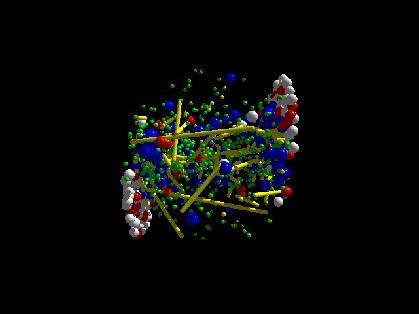Modeling Relativistic Heavy-Ion Collisions
The purpose of Transport Theory
A promising approach to connect the transient QGP state with the
experimentally observable hadronic final state
is the application of transport theory.
Transport theory offers the possibility to cast the entire
time evolution of the heavy-ion reaction
- from its initial state to freeze-out -
into one consistent framework.
In microscopic transport models the full
space-time evolution of all microscopic degrees of freedom - either
all hadrons present in the system or alternatively
(at higher beam energies) partons -
is calculated from the initial state to the final freeze-out, which allows
for quantitative predictions of QGP signatures.
Cartoon of a Ultra-relativistic heavy-ion collision. Left to right:
the two nuclei approach, collide, form a QGP, the QGP expands and
hadronizes, finally hadrons rescatter and freeze out
Microscopic Transport Theory
Microscopic Transport Theory treats the microscopic substructure of the
colliding nuclei explicitly, i.e. the trajectories and interactions
of all protons, neutrons and newly created
baryons and mesons in the case of hadronic transport models or quarks and
gluons in the case of a Parton Cascade are followed individually.
Microscopic transport models are most useful to tackle questions concerning
particle production, fluctuations and equlilibration mechanisms - they
do not rely on any mean-field or equilibrium assumptions.
Ultra-Relativistic Quantum Molecular Dynamics (UrQMD)
The
Ultra-relativistic Quantum-Molecular-Dynamics (UrQMD) model is
currently among the
most advanced microscopic string/hadron transport model available. It
has been successfully applied to heavy-ion reactions at the
Bevalac, SIS, AGS and SPS accelerator facilities, spanning incident
beam energies from 0.5 GeV per nucleon (at the Bevalac and SIS
facilities) up to 200 GeV per nucleon (at the SPS facility).
Main goals in the application of the UrQMD model
are to gain an understanding about the
following physical phenomena within a single transport model:
- Creation of dense hadronic matter at high temperatures
- Properties of nuclear matter, Delta & Resonance matter
- Creation of mesonic matter and of anti-matter
- Creation and transport of rare particles in hadronic matter.
- Creation, modification and destruction of strangeness in matter
- Emission of electromagnetic probes
The UrQMD model has also been used as a component of various hybrid transport
approaches, e.g.
- Hydro+UrQMD
- PCM+UrQMD
- UrQMD+deexcitation models for nuclear waste calculations
- GEANT4
- CORSIKA+UrQMD for air-shower simulations
 Click
here for a UrQMD movie
of an Pb+Pb collision at CERN/SPS energies (mpg format).
Click
here for a UrQMD movie
of an Pb+Pb collision at CERN/SPS energies (mpg format).
Parton Cascade Model (PCM)
The Parton
Cascade Model (PCM) is a microscopic approach with quarks and gluons as degrees
of freedom and interactions based on perturbative QCD. The PCM is ideally
suited to study the physics of deconfined colored quanta at the
RHIC and LHC accelerators,
particularly in the large momentum domain. It allows for the
description of the dynamics of the pre-equilibrium
early, hot and dense deconfined reaction phase and connects it to
experimentally observable quantities. Key physics issues to be addressed
in this approach are the mechanisms of parton equilibration, the
microscopic dynamics of jet-energy loss in a deconfined medium, the
production of heavy quarks and the emission of photons and dileptons
in the early, non-equilibrium phase of the reaction.
Currently our group is active in the development of the VNI/BMS implementation
of the Parton Cascade Model.
Hybrid Macro+Micro transport approaches
Hybrid macroscopical/microscopical transport models, employing hydrodynamics
for the early dense reaction phase and microscopic non-equilibrium dynamics
for the later, dilute reaction stages offer an alternative approach and
are particularly interesting for the investigation of the QGP equation of
state in the energy domains beyond beam energies of a 100 GeV per nucleon,
covered by the SPS, RHIC and LHC accelerators.


 Click
here for a UrQMD movie
of an Pb+Pb collision at CERN/SPS energies (mpg format).
Click
here for a UrQMD movie
of an Pb+Pb collision at CERN/SPS energies (mpg format).